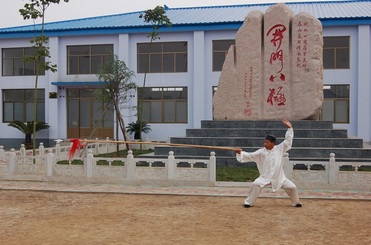Principles of BajiQuan :
Content : taolus and weapons
Master Wu LianZhi practicing six harmony big spear
Taolus : At the time of Wu Zhong, BajiQuan was only made of three forms: Xiaojia (小架,the small structure), DanDa (单打,single form) and its 2 persons set called DuiDa, and SiLang Kuan (四郎宽, SiLang’s extensions). XiaoJia is the fundamental form of BajiQuan and it uses the LiangYi Ding position as basic structure. The DanDa form is based on the vertical transformations of the LiangYi Ding position. Its 2 person set, called DuiDa, allows the practitioners to get familiar with hand to hand fighting. The SiLangKuan form is the longest and most refined form of BajiQuan, it is based on the horizontal transformations of the LiangYi Ding position. Until in the Fifties, its teachings was reserved to old families originating from MengCun, only a “public” form made of the first movements of the full form was taught outside the village. When Wu Zhong’s daughter got married with a ChangQuan expert, the style was enriched with 5 additional forms containing some elements of long fist mixed with BajiQuan. At present, only 2 of these forms have survived and are still practiced in MengCun: TaiZong Quan (太宗拳, TaiZong Emperor fist) and Fei HuQuan (飞虎,flying tiger fist). Starting from the beginning of the 20th century, Wu HuiQing and his son Wu XiuFeng (cf Masters) extended the content of BajiQuan by creating new forms (XingPi, BaoXing, Luohan Gong, etc.) based on his exchanges with experts of various styles.
Weapons: At the origin, the weapon training in BajiQuan was based on : three types of spear of various sizes, the “Willow leaf” broadsword, the “Spring and autumn” halberd and of the “Wanderer stick”. Thereafter, the style integrated different kind of straight sword, three section whip, and other types of broadsword practised in the area of CangZhou. However, the spear remains the reference weapon for BajiQuan, and more particularly the “6 harmony big spear” (六合大枪, LiuHe Da Qiang) which is a more than 3 m long spear which allows to the practitioner to develop the power release characteristic of the BajiQuan style.

